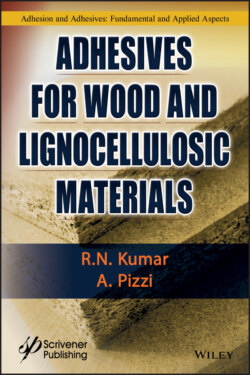Читать книгу Adhesives for Wood and Lignocellulosic Materials - R. N. Kumar - Страница 32
1.6 Effect of Hierarchical Structure of Wood on Adhesive Penetration
ОглавлениеThe flow of liquid resin into the porous structure of wood results in filling the cell lumens. The gross penetration occurs when resin diffuses into the cell wall or flows into micro fissures. Hydrodynamic flow is caused by an external compression force due to clamp pressure or pressure exerted by the hydraulic press. Flow then proceeds into the interconnected network of lumens and pits, with flow moving primarily in the path of least resistance [44].
The flow path of the liquid adhesive into the wood is determined by the resistance to the hydrodynamic flow. The least resistance is in the longitudinal direction through the lumens in the long and slender tracheids of softwoods, or through the vessels of hardwoods. Since vessels are connected end to end with perforation plates and no pit membrane, this cell type dominates the penetration of adhesives in hardwoods. Using optical microscopy, Kamke and Lee observed the presence of resin in pit chambers of both hardwood and softwood species and in cell lumens as a result of entry of the resin through a pit [44].
The rheology of the adhesives plays a significant role in the adhesive penetration. Polymeric adhesives exhibit non-Newtonian behavior [45]. Also, the capillary pathways through cell lumens and pits are tortuous. As a result, penetration of the adhesives through wood is further complicated.
Waterborne adhesives, such as the phenolics and amino resins, are heterogeneous with unique distribution of MWs. They are prone to separation (1) when the water is absorbed by the cell wall and (2) when the high MW polymer molecules are trapped by the pit membrane into different depths depending on the MW of the polymer (comparable to gel permeation chromatography). Because of the above wood-related factors, the influence of fluid dynamics of the adhesives on its penetration into wood cannot be generalized. Gross penetration can happen with most types of resin at low viscosity, while cell wall penetration can occur only with resins having small MW components. In order to determine what should be the critical molecular size of the adhesives below which they can penetrate into the cell wall, Tarkow et al. [46] studied the critical MW of polyethylene glycol (PEG) needed to penetrate the cell wall of Sitka spruce. Their study showed that the critical MW of PEG was 3000 at room temperature. MW fractions less than 3000 are common in the case of phenolic, amino resins, and isocyanate resins and therefore these resins can be expected to penetrate into the cell wall. Further, prior to polymerization, adhesives penetrating the cell wall swell and plasticize the wood. This is an additional factor in favor of penetration of these resins into the cell wall. This has been reported for pMDI and low MW PF adhesives [32, 47, 48].
While discussing the importance of gross and cell wall penetration with respect to the adhesion mechanisms, Frihart proposed four scenarios [49]. In the first case of micrometer penetration, the adhesive occupies the free volume within the cell wall—thus inhibiting shrinking and swelling. In the second case, there can be mechanical anchoring between the cured adhesive and the substrate. The third case is the formation of interpenetrating polymer network that is made up of the cross-linked adhesive within the free volume of the cell wall. The last case claims the formation of chemical cross-links with the cell wall polymeric components.
